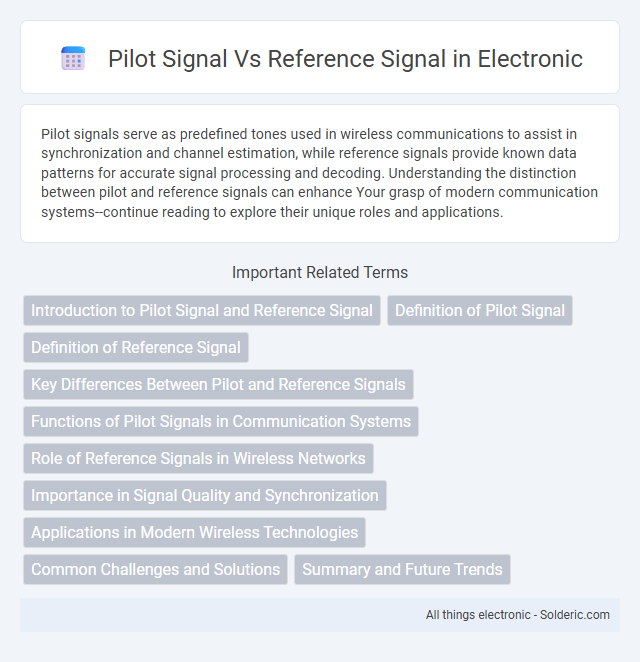Pilot signals serve as predefined tones used in wireless communications to assist in synchronization and channel estimation, while reference signals provide known data patterns for accurate signal processing and decoding. Understanding the distinction between pilot and reference signals can enhance Your grasp of modern communication systems--continue reading to explore their unique roles and applications.
Comparison Table
| Aspect | Pilot Signal | Reference Signal |
|---|---|---|
| Definition | Known signal embedded within transmission for channel estimation. | Known signal used as a baseline for synchronization and estimation. |
| Purpose | Facilitates channel estimation and equalization in communication systems. | Ensures timing, frequency synchronization, and aids in calibration. |
| Usage | Common in wireless systems like LTE, 5G for adaptive modulation. | Used broadly in signal processing for synchronization and measurement. |
| Signal Type | Embedded known sequence within data transmission. | Standalone known sequence or pattern outside data signals. |
| Frequency | Transmitted regularly in time and frequency domains. | May be transmitted intermittently or as needed. |
| Role in Channel Estimation | Primary reference to estimate channel conditions. | Supports initial calibration or complements pilot signals. |
Introduction to Pilot Signal and Reference Signal
Pilot signals and reference signals are essential components in wireless communication systems for channel estimation and synchronization. A pilot signal is a known, predefined waveform inserted into the transmitted signal to assist receivers in accurately detecting and correcting channel impairments. Reference signals serve as benchmarks or standards that receivers use to measure and compare the incoming data, enabling reliable demodulation and decoding processes.
Definition of Pilot Signal
A pilot signal is a predefined, known waveform transmitted alongside data to assist in channel estimation and synchronization in wireless communication systems. It enables the receiver to measure the channel characteristics, ensuring accurate signal detection and decoding. Your communication system relies on pilot signals to enhance signal quality and reduce errors caused by fading or interference.
Definition of Reference Signal
A reference signal is a predefined, known waveform used in wireless communication systems to facilitate accurate channel estimation and synchronization. Unlike pilot signals, which may carry additional data or serve multiple purposes, reference signals are primarily dedicated to providing a stable baseline against which the receiver can measure channel characteristics. Your device relies on these reference signals to decode information correctly and maintain reliable communication quality.
Key Differences Between Pilot and Reference Signals
Pilot signals are specific signals transmitted within a communication system to facilitate channel estimation and synchronization, typically occupying predefined time or frequency resources. Reference signals, also known as reference symbols or training sequences, serve as known patterns allowing receivers to measure channel characteristics and perform tasks such as equalization and decoding. The key differences lie in their roles: pilot signals primarily aid in tracking and synchronization, whereas reference signals are used for fine-grained channel estimation and correction, often differing in their placement and design according to system standards like LTE or 5G NR.
Functions of Pilot Signals in Communication Systems
Pilot signals serve as essential reference points in communication systems, enabling accurate channel estimation and synchronization. They assist in compensating for signal distortions caused by fading, Doppler shifts, and multipath propagation, ensuring reliable data transmission. Your system relies on pilot signals to maintain optimal performance and improve overall signal quality during wireless communication.
Role of Reference Signals in Wireless Networks
Reference signals in wireless networks provide essential channel state information (CSI) for accurate channel estimation, enabling reliable data transmission and reception. They serve as known signals transmitted alongside data to aid in synchronization, channel quality measurement, and equalization processes. Accurate reference signal design directly impacts link adaptation, beamforming efficiency, and overall network performance in LTE and 5G systems.
Importance in Signal Quality and Synchronization
Pilot signals serve as continuous, known reference points within a communication channel, enabling accurate channel estimation and coherent demodulation, which are critical for maintaining high signal quality. Reference signals, embedded within the transmitted signal, provide timing and frequency synchronization essential for aligning the receiver's parameters and minimizing distortion. Together, these signals ensure robust synchronization and optimize the overall reliability and clarity of wireless communication systems.
Applications in Modern Wireless Technologies
Pilot signals are fundamental in modern wireless technologies for channel estimation, synchronization, and coherent demodulation, ensuring reliable communication in systems like LTE, 5G NR, and Wi-Fi. Reference signals, a specific type of pilot signal, provide known data patterns that enable your device to accurately measure channel conditions and improve signal quality. These signals are crucial for adaptive modulation, beamforming, and MIMO techniques, enhancing spectral efficiency and network performance in contemporary wireless networks.
Common Challenges and Solutions
Pilot signals and reference signals both play critical roles in wireless communication systems for channel estimation and synchronization, yet they face common challenges such as interference, multipath fading, and frequency offset. Techniques like adaptive filtering, time-frequency resource allocation, and robust estimation algorithms help mitigate these issues by enhancing signal quality and reducing errors. Efficient pilot design and optimized reference signal patterns improve system performance by maintaining reliable channel state information under varying environmental conditions.
Summary and Future Trends
Pilot signals serve as fixed, known waveforms embedded within wireless transmissions to facilitate channel estimation and synchronization, while reference signals provide essential data for accurate decoding and coherent detection in modern communication systems. Advances in adaptive pilot signal design and machine learning-based reference signal optimization are driving improvements in spectral efficiency and robustness against interference. Future trends point towards dynamic pilot allocation, enhanced reference signal patterns for massive MIMO, and integration with AI for real-time channel state prediction, enabling next-generation 6G networks.
Pilot signal vs reference signal Infographic

 solderic.com
solderic.com